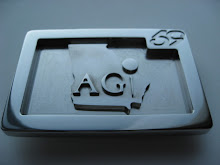by: B. J. Hathaway, G.S.E.B., M.C.I.
The correct ball position for golfers has always been a problem and part of the reason is this:
historical wisdom is not based on the geometry of the golf swing!
We've all heard it before, place the ball "here" in your stance for "this" club. Well that's all fine and good if you happen to carry a yardstick around the golf course, and your playing partners will allow you to take the time to measure your stance width, calculate the exact ball placement for that particular shot, remove the yardstick, waggle, look, waggle and swing. I have yet to see this happen and if you try it, you more than likely will not be invited back to play with your foursome!
The reason ball position should not, and cannot be related to stance width is because it does not provide a repeatable frame of reference. As you probably know, repeatability is the key to scoring in golf.
So let's find a better way. Why not use a reference based on something that does not change - like geometry. Luckily you will not need a slide rule and your old textbook. The hard work was done by Mr. Homer Kelley when he wrote the most comprehensive book ever written about the golf swing, The Golfing Machine.
The Golfing Machine is based on geometry and physics and how that applies to any and every golf swing. Since the golf swing is a circular motion, every circle has a low point in the arc. The low point in the arc of your golf swing is your left shoulder. Now we have a steady, dependable reference point. You take your shoulders everywhere you go. You cannot shuffle them around for better traction or change their width depending upon the lie at hand.
The driver is the longest club in the bag, so it should be in line with the left shoulder. As each club gets shorter it moves progressively backwards until the center of the sternum which is where the wedges are played. You may have to experiment a bit for your irons to find the ideal position for each, but once you have these established you are done unless you are hitting a specialty shot!
So, if we relate ball position to the shoulders, we get consistent placement. Consistent placement equals consistent flight patterns.
Get your ball position right and say goodbye to the blues!
The reason ball position should not, and cannot be related to stance width is because it does not provide a repeatable frame of reference. As you probably know, repeatability is the key to scoring in golf.
So let's find a better way. Why not use a reference based on something that does not change - like geometry. Luckily you will not need a slide rule and your old textbook. The hard work was done by Mr. Homer Kelley when he wrote the most comprehensive book ever written about the golf swing, The Golfing Machine.
The Golfing Machine is based on geometry and physics and how that applies to any and every golf swing. Since the golf swing is a circular motion, every circle has a low point in the arc. The low point in the arc of your golf swing is your left shoulder. Now we have a steady, dependable reference point. You take your shoulders everywhere you go. You cannot shuffle them around for better traction or change their width depending upon the lie at hand.
The driver is the longest club in the bag, so it should be in line with the left shoulder. As each club gets shorter it moves progressively backwards until the center of the sternum which is where the wedges are played. You may have to experiment a bit for your irons to find the ideal position for each, but once you have these established you are done unless you are hitting a specialty shot!
So, if we relate ball position to the shoulders, we get consistent placement. Consistent placement equals consistent flight patterns.
Get your ball position right and say goodbye to the blues!







No comments:
Post a Comment